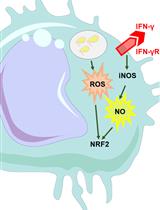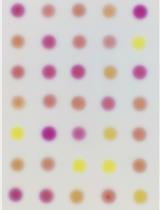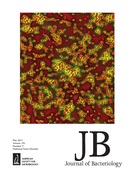- Submit a Protocol
- Receive Our Alerts
- Log in
- /
- Sign up
- My Bio Page
- Edit My Profile
- Change Password
- Log Out
- EN
- EN - English
- CN - 中文
- Protocols
- Articles and Issues
- For Authors
- About
- Become a Reviewer
- EN - English
- CN - 中文
- Home
- Protocols
- Articles and Issues
- For Authors
- About
- Become a Reviewer
H2O2 Kill Assays of Planktonic Stationary Phase Bacteria
Published: Vol 3, Iss 21, Nov 5, 2013 DOI: 10.21769/BioProtoc.953 Views: 10435
Reviewed by: Anonymous reviewer(s)

Protocol Collections
Comprehensive collections of detailed, peer-reviewed protocols focusing on specific topics
Related protocols

Hypochlorous Acid Staining with R19-S in the Drosophila Intestine upon Ingestion of Opportunistic Bacteria
Salma Hachfi [...] Armel Gallet
May 20, 2019 6279 Views

Continuous Measurement of Reactive Oxygen Species Formation in Bacteria-infected Bone Marrow–derived Macrophages Using a Fluorescence Plate Reader
Natascha Brigo [...] Christa Pfeifhofer-Obermair
Feb 5, 2023 2294 Views

Qualitative and Quantitative Methods to Measure Antibacterial Activity Resulting from Bacterial Competition
Boris Taillefer [...] Eric Cascales
Jul 5, 2023 3233 Views
Abstract
Stationary phase bacteria are highly tolerant to hydrogen peroxide. This protocol was developed to test the susceptibility to hydrogen peroxide killing in different Pseudomonas aeruginosa strains. This assay provides a reliable way to measure killing of stationary phase bacterial cells to hydrogen peroxide and can be adapted to test other oxidants.
Materials and Reagents
- Phosphate buffered saline (PBS) solution (Sigma-Aldrich, catalog number: P4417-100TAB )
- 30% w/w Hydrogen peroxide stock solution (RICCA Chemical, catalog number: 3821.7-32 )
- Sodium thiosulfate solution (dissolved in ddH2O) (Sigma-Aldrich, catalog number: S8503 )
- P.aeruginosa strains in freezer stock
- 25% Lennox broth (LB) medium (Becton Dickinson and Company, DifcoTM, catalog number: 240230 ) (see Recipes)
- LB agar plates (see Recipes)
Equipment
- 96-well plates
- Standard petri plates
- Spectrophotometer (cuvette) (Thermo Fisher Scientific, model: GENESYS 10S UV-Vis )
- Spectrophotometer (96-well plate) (Bio-Rad Laboratories, model: 680 )
- Cuvettes for OD600 reading
- Shaker-incubator at 37 °C, 250 rpm
- Static incubator at 37 °C
- Sterile glassware: 150 ml Erlenmeyer flask, capped or foiled
- Sterile 15 mm glass test tubes and plastic caps
- Sterile wire-loops (sterilized with 70% ethanol and flame)
Procedure
- Day 0. Streak P.aeruginosa cells from the freezer stock onto a LB agar place and incubate statically overnight at 37 °C.
- Day 1. Pick 4-5 single colonies from the P.aeruginosa agar plate with a sterile wired-loop and inoculate 15 ml liquid LB medium in a 150 ml Erlenmeyer flask. Grow liquid bacterial cultures overnight for 16-18 hours at 37 °C, with shaking at 250 rpm.
- Day 2. Inoculate 15 ml liquid LB medium in a 150 ml flask with 1:100 of overnight bacterial culture. Grow cells to for 16-18 hours at 37 °C, with shaking at 250 rpm.
- Day 3. Determine the OD600 of the culture and dilute the bacterial suspension to a starting concentration of ~2.5 x 106 cells/ml (in total volume 1 ml LB). Depending on the bacterial strain used, the OD600 to CFU ratio will differ and needs to be determined for each strain: for example, for the PAO1 wild type strain, 108 cells/ml = ~OD600 0.1.
- To confirm the correct starting bacterial density (at ~2.5 x 106 cells/ml), aliquot 100 μl of the above bacterial suspension into 96-well plate. Serially dilute cells 1:10 in PBS to approximately ~2.5 x 102 cells/ml, then plate 100 μl on LB agar plates for CFU count. This will also be the CFU count for time zero measurement.
- Set up ~2.5 x 106 cells/ml x 1 ml per sample in sterile glass tubes, with at least 3 replicates per strain per condition. For H2O2 treated samples, add H2O2 (1 mM (2 μl) to 5 mM (10 μl) or other desired final concentration) to each samples in test tubes. Include untreated controls that are challenged with PBS. Each condition should be done at least in triplicates. Incubate cells for 2 hours with shaking at 250 rpm at 37 °C.
- After H2O2 or PBS challenge, add 0.2% sodium thiosulfate to all samples to neutralize any remaining H2O2. Add even when samples are only challenges with PBS as a control.
- To determine the viable cell count in H2O2 or PBS treated samples, aliquot 100 μl of bacterial samples into 96-well plate, serially dilute cells 1:10, then plate 100 μl of each dilution on LB agar plates for CFU count. Incubate CFU count plates at 37 °C overnight.
- Day 4. Count CFU on LB agar plates and calculate the viable CFU per biofilm based on the dilution factors applied.
- Determine hydrogen peroxide killing by comparing the viable CFU count in the PBS treated and the H2O2 treated conditions.
Recipes
- 25% LB medium
5 g LB powder medium per L
Dissolved in ddH2O and autoclaved
- LB agar plates
LB medium with 1.5% agar
Dissolved in ddH2O and autoclaved
Acknowledgments
We would like to acknowledge CIHR (MOP-102727 to DN) and the Burroughs Wellcome Fund (1006827.01 to DN) for funding. This protocol was adapted from the previously published paper Khakimova et al. (2013).
References
- Khakimova, M., Ahlgren, H. G., Harrison, J. J., English, A. M. and Nguyen, D. (2013). The stringent response controls catalases in Pseudomonas aeruginosa and is required for hydrogen peroxide and antibiotic tolerance. J Bacteriol 195(9): 2011-2020.
Article Information
Copyright
© 2013 The Authors; exclusive licensee Bio-protocol LLC.
How to cite
Khakimova, M. and Nguyen, D. (2013). H2O2 Kill Assays of Planktonic Stationary Phase Bacteria. Bio-protocol 3(21): e953. DOI: 10.21769/BioProtoc.953.
Category
Microbiology > Antimicrobial assay > Killing assay
Biochemistry > Other compound > Reactive oxygen species
Do you have any questions about this protocol?
Post your question to gather feedback from the community. We will also invite the authors of this article to respond.
Tips for asking effective questions
+ Description
Write a detailed description. Include all information that will help others answer your question including experimental processes, conditions, and relevant images.
Share
Bluesky
X
Copy link








